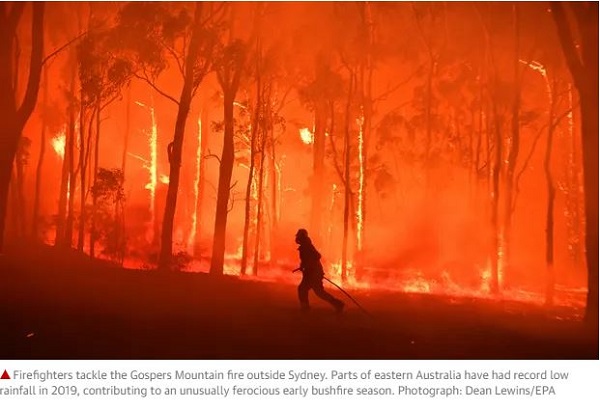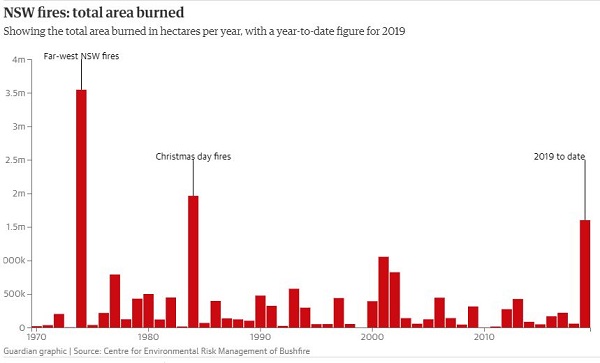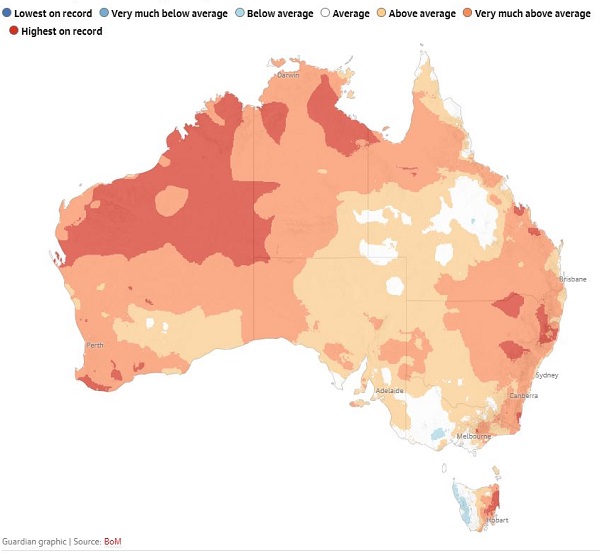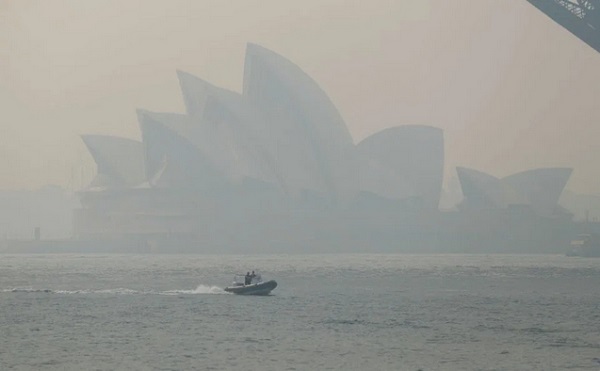
Some are still suggesting that there is no direct link between climate change and Australia’s 2019 early bushfire season.
Adam Morton, Nick Evershed and Graham Readfearn did a factcheck at The Guardian. This graph shows that with summer about to begin 2019 was already streets ahead of anything we’ve seen in NSW since 1984:

The 1974 fires were entirely different, produced largely by above average rainfall in the remote outback grassland country in the state’s far west. The 2019 fires follow a record drought. Here’s the
cumulative forest fire danger index (FFDI) for winter (June to August) 2019 compared with all winters since 1950. The FFDI combines measurement of rainfall, evaporation, wind speed, temperature and humidity, and the cumulative FFDI is the sum of daily values over the specified period.

In this ABC RN segment, Mark Howden, Australian National University professor and vice chairman of the Intergovernmental Panel on Climate Change, says the association with higher temperatures and changed climate is clear from the characteristics of the fire season and its concordance with what is happening world-wide.
David Spratt in Climate emergency (2): The scientific case says:
- Our climate is already too hot, with dangerous heatwaves and bushfires, droughts and crop failures, and coastal flooding becoming more intense and destructive.
As the climate warms towards 1.5°C what is now bad will become worse. He says we should aim for 0–0.5°C for a safe climate.
Remember, Gavin Schmidt of NASA GISS said we need near term emissions reductions of 70%, and then drawdowns of atmospheric CO2 in order to reduce temperatures.
Frankly, if we declare a world-wide climate emergency now achieving temperature reduction is likely to take half a century at least, probably a century or more. So we need to think how we will cope along the way. Hugh Riminton in an episode of ABC RN’s The Roundtable spoke to David Bowman, Professor of pyrogeography and fire science at the University of Tasmania, John Brockhoff, National Policy Manager for the Planning Institute of Australia, and Liz Campbell, Mayor of Kempsey Shire on this very issue.
Firstly, effort needs to be put into optimising the fire resistance of existing buildings, planning for orderly evacuation of vulnerable areas, possible road congestion, planning for safe areas, tuning up the warning system and so on.
Secondly, thought needs to be given to planning implications and building codes, given the increased risk.
Thirdly, the system of using ageing volunteers in fire-fighting had been stretched to breaking point. Prof Bowman in particular said we needed now to choose whether we would go down the American route to a bigger fire fighting force, more fire-fighting aircraft and effectively declaring war on fires.
If we did, he said, we would spend billions and lose, just like the Americans are losing.
The only rational alternative was pre-emptive hazard reduction including mosaic burning. Here local knowledge and skills are required, also coordination across private land, state forests and national parks. Permits and paperwork are inevitable, because there is liability if things go wrong.
Fire is obviously location-specific, so the implications for local government are huge. However, there is also a clear case for state support, plus national support and leadership. Opposition Leader Anthony Albanese was right to call for a special COAG meeting to deal with ongoing bushfires and other disasters in a coordinated way.
If we are to professionalise fire prevention and build more resilient communities, dollars will be needed which will stretch state funds. Prof Bowman also counselled that the fire prevention pot should be kept separate from the fire-fighting pot. Otherwise fire fighting will take priority, and as a result we end up losing the war.
Meanwhile, courtesy of Lethal Heating:
- As Smoke From Bushfires Chokes Sydney, Australian Prime Minister Dodges On Climate Change from Time magazine, and
The Time piece is a concise and accurate report of the whole episode.
The SMH piece tells us that our contribution to World War I was just 1.3 per cent of the allied total.
No one country can solve the challenge but each must play its part.
Countries with emissions under 2 per cent of the global total make up around 40 per cent of global emissions. This includes Germany whose leadership on the renewable energy revolution would not have happened had it thought itself irrelevant and balked.
And:
- The fires in all their fury are telling us we must recognise the full seriousness of what is in front of us and step up.
That needs a plan, with policies for coming decades; uncertainty is no guide for the massive investments required for clean, green economic transformation and a defeatist view of our relevance is no compass for Australia to be the agent of our destiny.
Ask the Anzacs.
This image won’t be used to promote tourism:

When looking at our effort the world may well ask the question:
-
Where the bloody hell are you?
Earlier post:

New post.
The main issue is how to devise and implement a fire minimising strategy as well as strengthening fire fighting resources which depend excessively on ageing volunteers.
Brian: Australia has an enormous range of climates and ecologists. What we are seeing now is an adjustment to climate change, not the end of the world with the extensive fires an indicator.
For example, the Pilbara is a wee bit hotter than most of Australia with the natural fires driven by lightning strikes in the summer storm season. The fires seem to be more extensive than they were in the past because firestick farming with the moziac environment it produces has gone.
The question for wider Australia is “Will the 2019 fires change ecologies in a way that reduces the risk of widespread fires like we have seen this year.
Problem at the moment is that the Nats see the 2019 fires as an opportunity to surge ahead with activities that are not supported by sound scientific investigation, pro dam and not national park friendly.
I think a lot could be done in the insurance area.
Perhaps an actual assessor visit the property at application and premium setting time rather than after shit hits the fan.
Assess whatever the policy is meant to cover, in this case fire, and set appropriate rates.
If Bill in Bungalungadurri has a block home with steel trusses, leaf guards and no bushland for 100m, yet Tristan up the road has a timber Queenslander with bushland up against 3 sides of his home they shouldn’t pay the same premiums.
That should encourage preparedness and reduce risk of bushfires.
I’ll concede this much, the insurance industry is the biggest example of market failure there is. Primarily because we let them insure us in a collective fashion rather than individually.
( that’s not a call for more regulations, rather a need for competitors and education and any governmental barriers to new players removed )
History suggests insurance companies, being very risk averse, will simply refuse to cover anyone who lives in Bungalungadurri for fire.
zoot
Haa!!
Perhaps inadvertently you’ve agreed with me.
That’s 3 times I think.
Consider this:
https://www.recreatingthecountry.com.au/blog/deciduous-trees-can-provide-crucial-bushfire-protection
I drew attention to the protective nature of various trees to my local then Liberal Federal member in the early 2000’s. No action taken.
Bilb: The use of screening trees with fire resistant foliage came up in discussions about the black Friday fire. By contrast, eucalyptus compete by encouraging fires that are hot enough to kill the competition including houses that are invading their patch.
Hi John D,
Its not about the fire retardant foliage as much as it is about the shape of the trees. Deciduous trees are generally roughly cone shapes sitting base to the ground and as such block the flow of air near the ground. This forces the air flow of the high velocity killer fires to rise above the ground creating a protected pocket behind the tree screen. Watch video of the Canberra fire to see how clear space creates a blowtorch effect at ground level. This was very evident in the Springwood fire which travelled a devastating speed behind my sister’s house but here there was more evidence of trees and hedges protecting houses.
Eucalypts are also conical shaped but inversely with their apex pointing down and well clear of the ground. This allows air flow to ignite the highly combustible tree fall to sustain the fire and when the air flow is high enough provides the heat to set off the famous Australian high velocity crowning fire, which I personally witnessed in the 1968 Blue Mountains fire.
Interspersing deciduous trees amongst eucalypts has a cooling effect that is the best chance of protecting communities such as the recent NSW South Coast fires and even the Hobart fire where houses are embedded in the forest. But of course that takes understanding of nature and forethought, more commonly seen in indigenous people.
BilB
One factor in favour of the deliberate plantings you suggest, is that the blind (ideological?) advocacy of ripping out European trees/shrubs and replacing them with indigenous species* seems to have subsided.
I appreciate that indigenous plantings attract native birds, may reduce garden watering, and may help to preserve local species BUT there are other factors to consider, fire safety being one.
*over here in Queen Victoria’s State, I estimate that enthusiasm was strongest around 1970 to 1985. At that time folk were also campaigning to stop the Franklin River dam, create more national parks, and reduce the clear-felling of eucalypt forests for wood chipping.
And
Groetjes BilB!!
Ambi van Oldenbarnevelt
I loved this thread by Bruce Walker, firefighter & resident of Wytaliba, wiped out by bush fires near Glen Innes.
It corrects the record on disinformation spun by multiple politicians and MSM about the folks who lived there, the background and underlying causes and lies about hazard reduction.
Bruce has got the science right and understands the relationship between cutting down trees, atmospheric moisture rain and fires. Best of all, the language he used to express these things filled me with awe.
Unfortunately the views of the coal sniffers are getting more space in the media.
Thanks John.
That is wonderful.
A
If I were not a libertarian and an arson profiler criminal psychologist I’d suggest an ankle bracelet for that Chap.
But I am and I’m not so don’t worry about it….
Anthony, is that you?
Zoot
No, Anthony is my cousin and Cowboys fan.
We have wonderfully entertaining discussions.
In the spirit of the recent quid pro quo fascination, why do you troll with pathetic shit without substance or argument?
Or is that the nature of a self confessed racist and obvious troll that you’ve no need to answer ?
Complementary English tip: when someone writes
it is a statement that they are an arson profiler criminal psychologist.
If that is not so it would be better expressed